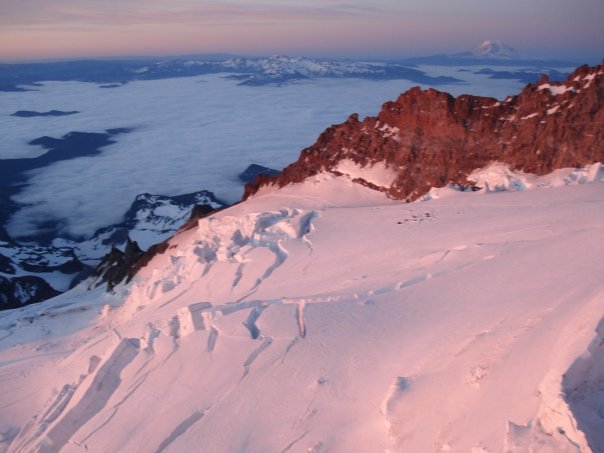
It’s BIG. It is the fifth highest mountain of the continental USA and the highest volcano of the Cascade Range. This massive mountain is the most heavily glaciated peak in the contiguous United States with multiple glaciers and routes of all technical levels. Mount Rainier offers an exciting challenge to the mountaineer. That’s why a lot of climbers attempt it.
So far I’ve attempted the climb four times with one successful summit. Not exactly the best track record. My first two attempts were fun trips even though we didn’t summit – one because of poor planning/training (newbs) the other because of bad weather. A third attempt finally brought success and some more great stories. My fourth attempt was a new sport for me; ski mountaineering (AT). Using gear that’s a cross between telemark and downhill skis enabled me to “skin” up like a cross country skier, yet lock those heels down for some serious alpine skiing on the way down. Poor training on my part stopped me from making the summit on that trip, but the ride down was incredible. Longest single-run downhill vertical ski of my life.
I have some great climbing buddies and we know our stuff so we’ve never had to fork over the big bucks for guide services. I hear they charge $1,000 plus! To each his own I suppose. I recommend taking a mountaineering course and climbing it with trusted friends instead of wealthy strangers. An annual climbing permit is only $30.
The reason I bring any of this up is simple. I need to jazz this blog up with some awesome photos of my climbing trips to Mt. Rainier. So without any further ado. Pictures!









Chandler says
Hi,
Im writing an essay about Mount Rainier for a class that im taking. Would you mind answering a questions for me?
1. Why is Mount Rainier so heavily glaciated?
Thank you,
Chandler
Jake Douville says
Hi Chandler,
I couldn’t say exactly why, as I’m not an expert in glaciers. If I had to guess, part of the reason would be because of it’s huge size. It is a massively prominent peak, in terms of it’s height above the surrounding peaks and as well as the size of it’s total surface area.
According to the Nation Park Service over 35 square miles of permanent ice and snow cover Mount Rainier. Of all the glaciers in the contiguous U.S., Mount Rainier’s Emmons Glacier has the largest surface area (4.3 square miles). Carbon Glacier is the longest (5.7 miles), thickest (700 feet), and has the lowest terminus elevation (3,500 feet) in the contiguous U.S.
The United States Geological Survey states that the size of glaciers on Mount Rainier has fluctuated significantly in the past. For example, during the last ice age, from about 25,000 to about 15,000 years ago, glaciers covered most of the area now within the boundaries of Mount Rainier National Park and extended to the perimeter of the present Puget Sound Basin.
I hope this helps with your essay. I found most of the information above at the following websites:
Wikipedia – Mt. Rainier
SummitPost – Mt. Rainier
National Park Service – Mt. Rainier